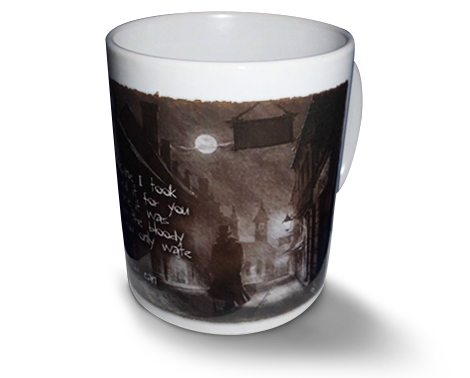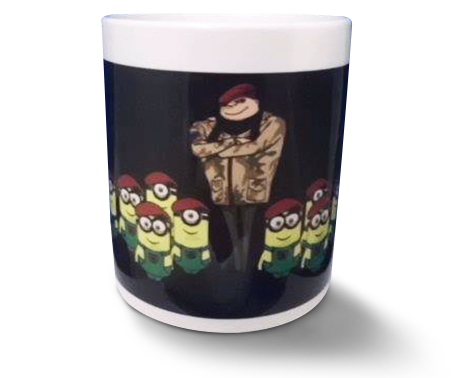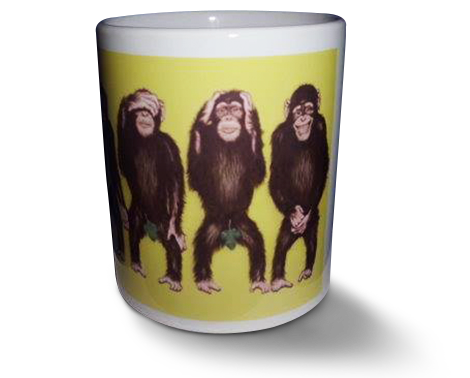The Fuhers military mug
11oz dishwasher safe mug These mugs are not intended to offend anybody and supposed to be fun and comical
Word Origin and History for Führer Expand
Fuhrer
n.1934, from Führer und Reichskanzler, title assumed by Hitler in 1934 ashead of the German state, from German Führer "leader," from führen "tolead," from Middle High German vüeren "to lead, drive," from Old HighGerman fuoren "to set in motion, lead," causative of Old High German faran"to go, travel," which is cognate with Old English faran (see fare (v.)).Hitler's title was modeled on Mussolini's Duce.
IN GERMANY, as in the rest of Europe, copyright expires seven decades after the author’s year of death. That applies even when the author is Adolf Hitler and the work is “Mein Kampf”. Since 1945, the state of Bavaria has owned the book’s German-language rights and has refused to allow its republication. German libraries stock old copies, and they can be bought and sold. But from January 1st no permission will be needed to reprint it.
Those living outside Germany may not immediately grasp the significance of the moment. “Mein Kampf” has always been available in translation and is now just a click away online. But that is not the point. For Germans, the expiry of the copyright has caused hand-wringing and controversy. The question, as they ring in the new year, is not what to do about “Mein Kampf” as it enters the public domain. Rather, it is what Hitler means for Germany today.
“Mein Kampf” is a mix of autobiography and manifesto that Hitler began writing during a rather comfortable prison stay after his failed putsch of 1923. It was first published in two volumes in 1925 and 1926. The title means “My Struggle”, and Hitler certainly struggled with syntax, grammar and style. One contemporary reviewer ridiculed it as “Mein Krampf” (My Cramp). Much of it is dull or incomprehensible today.
Woven into the prose are crude Social Darwinism and anti-Semitism that resonated even beyond Germany, as well as hints of the author’s murderous potential. Having been gassed by the British in the first world war, Hitler writes: if some of the “Hebrew corrupters of the people had been held under poison gas, as happened to hundreds of thousands of our very best German workers in the field, the sacrifice of millions at the front would not have been in vain.”
It is not clear how many Germans read the tome. But after 1933, when Hitler seized power, it became a bestseller. From 1936 some municipalities gave it to newlyweds after their vows, and by the end of the second world war about 13m copies were in print.
After the war it fell to the Americans to decide what to do about the book, because Hitler’s last private address, in Munich, was in their sector. The Third Reich was gone and the Federal Republic of Germany would not be born until 1949. So the Americans transferred the rights to the government of Bavaria. It banned printing of the book.
This approach reflected the first post-war phase in the German treatment of Hitler’s legacy. The idea was to suppress anything that might tempt the Germans to fall back under his spell. The Allies and the new German government followed a policy of “de-nazification”, under which known Nazis were banned from important positions. But as the cold war unfolded, West Germany was needed as an ally. For lack of alternatives, ministries, courtrooms and schools employed former Nazis again.
In the late 1940s and 1950s Germans avoided discussing Hitler. Many men were returning from captivity. Many women had been raped. People had been displaced, orphaned or widowed. Germans had been both perpetrators and victims, and had no words for their state of mind. Many were traumatised and could not bear to talk about their experiences. They found it psychologically easier to dwell in the present and keep busy with the Wirtschaftswunder, the post-war “economic miracle”. Many still denied the full scale of the Holocaust. According to Thomas Sandkühler, author of “Adolf H.”, a recent biography, a poll in the 1950s found that almost half of West Germans thought Hitler would have been “one of the greatest German statesmen” if he had not started the war.
A new phase began in the 1960s, after the Israelis captured, tried and executed Adolf Eichmann, a leading Nazi. This made more details of the Holocaust public. Starting in 1963, 22 former SS men were prosecuted in Frankfurt for their crimes in Auschwitz. The Germans were glued to these cases: 20,000 people went to the Frankfurt courtroom during the sessions. For the first time Vergangenheitsbewältigung (“coping with the past”) came to kitchen tables, where it split families.
Sons and daughters accused their parents and professors of complicity and rebelled at home and on campus. Their elders retreated into sanitised tales of what they had done or lived through. A husband-and-wife team of psychoanalysts, Alexander and Margarete Mitscherlich, called this pathology “the inability to grieve” in a book of that title published in 1967. This mired the Germans in an ongoing moral and psychological crisis, they thought.
Official Germany found two responses. East Germany adopted the fiction that its righteous communists had resisted the “fascists” all along. In effect, it never reckoned with the past. But West Germany accepted its guilt and atoned publicly. It became a pacifist society, often called “post-heroic” in contrast to the Allies’ warrior cultures. It also became “post-national”: West Germans rarely flew their flag and barely whispered their anthem at sporting events. The young sought identity either sub-nationally (as Swabians or Bavarians, say) or supra-nationally, as good Europeans.
But starting in the 1970s a pent-up fascination with Hitler began to re-emerge. Two biographies and a documentary came out, and in 1979 Germany aired “Holocaust”, an American television series, which shocked Germans into a new round of soul-searching. Many changed their perceptions in a way that Richard von Weizsäcker, then West Germany’s president, expressed in a historic speech in 1985, on the 40th anniversary of Germany’s surrender. May 8th 1945 was not the date of Germany’s defeat and collapse, he said, but of its liberation.
After reunification in 1990—the formal end of the post-war era—the German public became ravenous for more research. Der Spiegel, a weekly news magazine, featured Hitler on its cover 16 times during the 1990s. A book by an American historian, Daniel Jonah Goldhagen, in which he argued that ordinary Germans were “Hitler’s Willing Executioners”, became a hit. A museum exhibition about the Wehrmacht, Germany’s wartime army, argued that ordinary soldiers (rather than just the SS) had participated in the Holocaust. Germans queued around the block to see it.
But there was a parallel trend towards what Germans call “Hitler porn” and “Hitler kitsch”. The Führer became a marketing tool. It started in the 1980s when Stern, a magazine, published what it alleged was Hitler’s diary, a sensation that turned out to be fake. Since the 1990s the history channel on German television has aired almost nightly documentaries on Hitler’s women, henchmen, last days, ailments, table silver or German Shepherd dog (called Blondi). Any footage of the small man with the toothbrush moustache draws an audience. In that way, Hitler has become like sex and violence: bait to sell copies or to grab attention.
But this fascination also suggests a new distance. Most of the audience, after all, now have no personal recollection of Hitler. This explains another genre: satire. During his lifetime, it was Germany’s enemies who parodied Hitler, as in Charlie Chaplin’s film of 1940, “The Great Dictator”. But in 1998 Walter Moers became the first German satirist to score a hit with a comic strip, “Adolf, die Nazi-Sau” (“Adolf, the Nazi pig”). Its producer called the character “the greatest pop star we’ve ever created”.
The latest bestseller is “Look Who’s Back” by Timur Vermes, translated into English this year. Hitler wakes up in today’s Berlin near his old bunker. Disoriented at first, he so amuses everybody he meets, including his Turkish dry-cleaner, that he is launched on a meteoric career as a comedian. His hip colleagues are convinced that he is a consummate “messed ekta” (Berlinish-English for method actor) offering a subtle critique of modern media culture.
For young Germans the Führer has thus receded far enough into the past to seem outlandish and weird rather than potentially seductive. In “Look Who’s Back”, he regurgitates inane phrases from “Mein Kampf”, such as: “The titmouse seeks the titmouse, the finch the finch, the stork the stork, the field mouse the field mouse…” But the words and the diction, with its famously rolled “r”, have no effect other than hilarity.
For the football World Cup in 2006 the black-red-and-gold came out everywhere
One by one, post-war taboos connected to Hitler are vanishing. Flag-waving is one. A breakthrough occurred in 2006, when Germany hosted the football World Cup. For the first time since the war the black-red-and-gold came out everywhere, draping balconies, prams, cars and bikinis. But so did the flags of the visiting countries, and Germany turned into one big street party. Hosts and visitors perceived it as nothing but fun.





